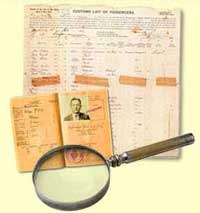| (insert your NIE or newspaper logo here) |
Weekly Online LessonOnline Lesson ArchiveGrade Level: 5-8
|
Immigrants in America
 In
his address to the nation on Thursday, March 23, 2006,
President George W. Bush pushed proposals for reforming
and enforcing immigration policies.
In
his address to the nation on Thursday, March 23, 2006,
President George W. Bush pushed proposals for reforming
and enforcing immigration policies.
Mostly, his proposals target people who have entered and work in the U.S. illegally, which number about 11.5 million people, experts estimate.
In the future, Bush proposes, these undocumented immigrants would likely be deported back to where they came from. Doing this, some argue, could make social and economic problems worse than if we let them stay here illegally.
People have migrated to the United States—legally or illegally—for a variety of reasons. Most come here looking for a better, or at least different, life than they had at home. Some come for employment, some come to be with family members already living here, and some may come to avoid political persecution in their native country.
No matter what the reason, the fact is that about one million people every year legally migrate to and live in the United States. From 1820 to 2004, a total of about 70 million people have done so. Without immigration, our nation would have grown much more slowly and with relatively little diversity.
To get an idea of how migration has influenced parts of our collective culture, take a look through your local phone book. How many different types of last names, or "surnames," are there? How many people have the same, or a similar, surname as you?
This week you'll investigate where people have come from and why they decided to migrate to the United States. You'll also compare major immigrant groups over the years, and get a chance to think about how they have influenced American culture.
Ellis Island
 Before
1855, tracking migrants into the U.S. was the duty
of each state. Between 1892 and 1954, however, a place
called Ellis Island—in New
York Harbor and near the Statue of Liberty—became a central processing
center for new migrants into the country. And although
there were other big ports of entry, it's believed
that more than 100 million Americans are directly related
to the 12 million migrants who passed through Ellis
Island.
Before
1855, tracking migrants into the U.S. was the duty
of each state. Between 1892 and 1954, however, a place
called Ellis Island—in New
York Harbor and near the Statue of Liberty—became a central processing
center for new migrants into the country. And although
there were other big ports of entry, it's believed
that more than 100 million Americans are directly related
to the 12 million migrants who passed through Ellis
Island.
So let's begin the lesson at Ellis Island. Start with the Immigrant Experience and take a look at the The Peopling of America timeline.
Explore each era—pre-1700, 1790-1820, 1820-1880, 1880-1930, 1930-1965, and 1965-2000. Make a chart with the eras on the x-axis and numbers of migrants on the y-axis. Use a different colored line to represent each different nationality. Also for each nationality, list or summarize primary reasons for peaks in immigration during one or more eras.
Next, find out how Family Histories can be traced to reveal clues about a person's ancestral roots:
- Margaret Feeney—My Irish Journey
- Char McCargo Bah—Putting My Family Back Together
- Byron Yee—Discovering a Paper Son
- Alex Woodle—Searching for the Lost Jews of Bohemia
- Mary Sevilla—Secrets of My Ancestors
- Jennifer Petrino—An Italian Family Returns Home
 What
were the clues each person used to track down the movements
of their ancestors? What other kinds
of information did they find along the way?
What
were the clues each person used to track down the movements
of their ancestors? What other kinds
of information did they find along the way?
Now, Search for any immigrants who shared your own surname. Type in your last name only to get the broadest results. If no exact matches come up, choose a close match. When a list pops up, choose one or more passengers to explore further. Click for Ship Manifest and View Text Version Manifest to see details about the passenger list, ages, and ethnicities of each passenger.
Are there any passengers who may be related? If so, based on their ages and genders, what kind of guesses can you make about their relationships? If no similar names to yours come up, why do you think that's the case?
Before leaving Ellis Island, read about the center's first arrival, Annie Moore, see who some of the Famous Arrivals were, and check out the Photo Album. Why do you think some surnames changed when they entered the U.S.? In what ways have immigrants contributed to American culture?
The New Americans
 As
illustrated in the Peopling of America timeline, the
types of ethnic groups migrating to the U.S. have changed
over the years. For example, the number of migrants from
European countries has decreased, while immigrant numbers
from Mexico, the Philippines, and other countries have
increased.
As
illustrated in the Peopling of America timeline, the
types of ethnic groups migrating to the U.S. have changed
over the years. For example, the number of migrants from
European countries has decreased, while immigrant numbers
from Mexico, the Philippines, and other countries have
increased.
To understand how immigration today compares with the Ellis Island era, explore some viewpoints of The New Americans using the Independent Lens at PBS.
Begin with the section called, Meet the New Americans. Reading each introduction and the related episode pages, you will get to know The Ogoni Refugees, The Palestinian Bride, The Dominican Baseball Players, The Mexican Laborer, and The Indian Technical Worker.
Why did each person want to move to the United States? How long does each one plan to stay? What are some of the challenges they face? What are some of the rewards?
Next, discover some of the Cultural Riches these new immigrants bring to America: Art, Music, Food, and Language. Have you noticed or experienced any of these influences in parts of American culture?
Lastly at this site, take the Immigration Myths & Realities Quiz. Did any of the answers surprise you?
Newspaper Activities
Pick out two or three surnames of people interviewed in Targetnewspaper articles. For this week's project, you will use each surname to search for a possible relative who came through Ellis Island. Then, you will decide on just one of the surnames to research further. You will analyze the current distribution of that name in the United States, and then write a fictitious story that traces the original immigrant to the person named in the article.
At the Ellis Island site, type in each surname and do a Passenger Search. To help you organize your research and develop your fictitious genealogy, print out the Charts & Forms. Based on the information you find there, choose one person or family and write down their genders, ages, and ethnicity. Based on the year they arrived, research what historical events were going on in their native country. This may help explain what prompted the family to migrate. Next, visit the Switchboard website to Find a Person, plugging in only the surname. When a list of people pops up, print out the list and write on a map where each one lives. In doing this, you may discover clusters of people with that last name, which may provide a clue as to where an original immigrant family settled once they left the processing center.
Now, take what you've learned and write a first-person narrative from the viewpoint of the original immigrant. Explain why and how you came to America, if you came with any family members, and then where you may have settled and for what reasons. What kind of job did you have? What were some of the day-to-day challenges you faced? Did you already speak English? Continue your story by telling how your direct descendents (who carried the same name) lived and moved around the country. Also, include any kind of ethnic influences your family may have had on their communities. End the story with the person featured in the local news article.
© Copyright 2006
Learners Online, Inc.
